
The genus Crambus includes around 155 species of moths in the family Crambidae, distributed globally. The adult stages are called crambid snout moths, while the larvae of Crambus and the related genus Herpetogramma are the sod webworms, which can damage grasses.

Spodolepis substriataria is a moth of the family Geometridae first described by George Duryea Hulst in 1896. It is found from Alaska to Nova Scotia, south in the east to New Jersey and in the west to California.

Myelois is a genus of small moths belonging to the family Pyralidae. They are found in western Eurasia and adjacent regions such as the Maghreb.
Apomyelois is a genus of small moths belonging to the family Pyralidae. The genus was erected by Carl Heinrich in 1956.

Ectomyelois ceratoniae, the locust bean moth, more ambiguously known as "carob moth", is a moth of the family Pyralidae. It has a nearly cosmopolitan distribution.

The Phycitinae are a subfamily of snout moths. Even though the Pyralidae subfamilies are all quite diverse, Phycitinae stand out even by standards of their family: with over 600 genera considered valid and more than 4000 species placed here at present, they unite up more than three-quarters of living snout moth diversity. Together with the closely related Epipaschiinae, they are apparently the most advanced lineage of snout moths.
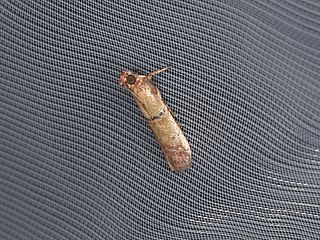
Atheloca subrufella, the palm bud moth or coconut moth, is a species of snout moth described by George Duryea Hulst in 1887. It is found in the US states of Georgia and Florida, and in northern Mexico, Cuba, the Virgin Islands and Brazil.
Apomyelois cognata is a species of snout moth in the genus Apomyelois. It was described by Staudinger in 1871, originally in genus Myelois.
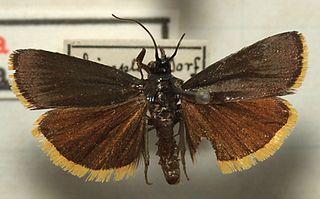
Catastia is a genus of snout moths. It was erected by Jacob Hübner in 1825, and is known from Bosnia and Herzegovina, Austria, Italy, and Greece.
Catastia bistriatella is a species of snout moth in the genus Catastia. It was described by George Duryea Hulst, in 1895. It is found in North America, including California.
Coenochroa illibella, the dune panic grass moth, is a species of snout moth in the genus Coenochroa. It was described by George Duryea Hulst in 1887. It is found in North America, including Texas, Arizona, Colorado, California, Indiana and Ontario.
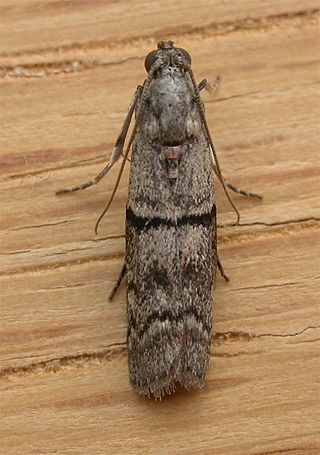
The Phycitini are a tribe of moths of the family Pyralidae.
Acrobasis comptoniella, the sweetfern leaf casebearer, is a species of snout moth in the genus Acrobasis. It was described by George Duryea Hulst in 1890 and is known from eastern Canada and the United States.

Acrobasis caliginella is a species of snout moth in the genus Acrobasis. It was described by George Duryea Hulst in 1878. It is found in the US states of California and Arizona.
Cactobrosis fernaldialis, the blue cactus borer, is a species of snout moth in the genus Cactobrosis. It was described by George Duryea Hulst in 1886, and is found from Texas to southern California, where it inhabits deserts.
Yosemitia graciella is a species of snout moth in the genus Yosemitia. It was described by George Duryea Hulst in 1887. It is found in the US states of Arizona, California, Nevada, Colorado, New Mexico and Texas.
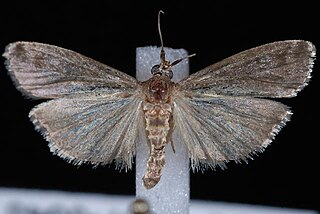
Oreana is a monotypic snout moth genus described by George Duryea Hulst in 1887. Its only species, Oreana unicolorella, described by Hulst one year earlier, is known from most of North America.
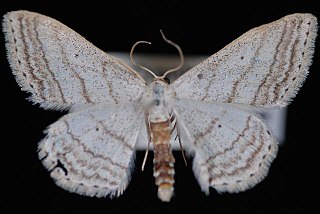
Scopula ancellata, the angled wave moth or pointed-winged wave, is a moth of the family Geometridae. It was described by George Duryea Hulst in 1887. It is found in North America from Quebec west to the Northwest Territories and British Columbia and south to Michigan, Indiana and Arizona. The habitat consists of mixed wood and coniferous forests.

Eupithecia misturata is a moth in the family Geometridae first described by George Duryea Hulst in 1896. It is widely distributed in western North America.
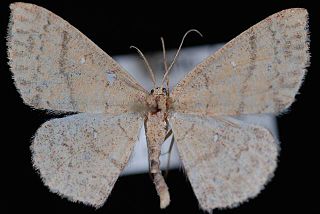
Cyclophora dataria is a moth in the family Geometridae. It is found in North America, from British Columbia to California, east to Arizona and north to Montana. The habitat consists of mixed or deciduous woods with Quercus species.













